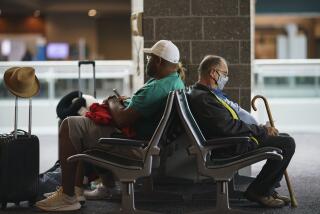Avoiding Ear Problems Aloft
- Share via
Flying can be miserable for travelers with ear problems, colds or allergies. When air pressure within the cabin changes, intense ear pain can follow. Takeoffs and landings are often the worst times.
Ear problems are, in fact, the most common medical complaint of airplane travelers, according to medical experts at the American Academy of Otolaryngology--Head and Neck Surgery. How and why do they occur?
When air pressure changes, the Eustachian tube--which links the middle ear with the back of the nose--must function properly or ear pain results. If working efficiently, the tube opens frequently and widely enough to equalize pressure changes. When it doesn’t work properly, there is ear pain because pressure on one side of the eardrum, in the middle ear, is greater than the pressure on the other side. When the pressure is unequal, the ear feels blocked or stuffed.
“At sea level, your ear may feel a little stuffy if the Eustachian tube is not working,” said Dr. Ronald Roth, an otolaryngologist with Santa Monica Hospital Medical Center and USC associate professor of surgery. “But in an airplane, with rapid pressure changes, that rapid change (often) cannot be compensated for, and the eardrum gets deformed one way or the other.” When the drum is sucked inward or stretched, it becomes painful.
Children are particularly prone to ear problems aloft because their Eustachian tubes are narrower than an adult’s and not as efficient, Roth said. Travelers who fly with sinus infections, allergies or colds--something generally discouraged by physicians--are also more likely to suffer blocked tubes.
To ease or prevent the discomfort, do-it-yourself remedies abound, all aimed at activating the muscle that opens the Eustachian tube.
Swallowing vigorously can help, as can chewing gum. Yawning widely is another approach.
Staying awake during descent can also help since sleeping travelers may not swallow often enough to keep up with airplane pressure changes.
During takeoffs and landings, babies should be kept awake too. Feed them a bottle or give them a pacifier to promote swallowing, pediatricians recommend.
Using an over-the-counter decongestant pill or nasal spray about an hour before descent can also help. Roth tells patients to take the over-the-counter decongestant as prescribed on the package the day before, as well as the day of the flight. Using a non-prescription nasal spray during descent might help too, he added.
And now there are special earplugs designed to minimize ear pain aloft. Called EarPlanes, the plugs were developed at the respected House Ear Institute in Los Angeles. Made of silicon, the plugs are about an inch long and a half-inch in diameter. They look like standard ear plugs used to muffle noise, but inside each plug’s silicon tube is a tunnel-like channel that contains a tiny filter made of a special porous material.
“The filter functions as a slow leak,” explained J. Phil Mobley, director of engineering for the House Ear Institute. “It allows the Eustachian tube more time to equalize pressure between the middle ear and the air pressure in the cabin.”
EarPlanes ($3.99 a pair) will be available this fall in selected drugstores in the East.By Thanksgiving they will be sold in major airport terminals; by year’s end they are expected in drugstores nationwide.
If ears still become painful despite preventive measures, there are other approaches. Consider the inflation technique recommended by the American Academy of Otolaryngology--Head and Neck Surgery: Pinch nostrils shut and take a mouthful of air. Use cheek and throat muscles only to force air into the back of the nose, pretending to blow thumb and fingers off the nostrils. A pop in the ears signals unblocking.
If ear pain persists for 12 to 24 hours after flying, see a doctor.
*
The Healthy Traveler appears the second and fourth week of every month.
More to Read
Sign up for The Wild
We’ll help you find the best places to hike, bike and run, as well as the perfect silent spots for meditation and yoga.
You may occasionally receive promotional content from the Los Angeles Times.






